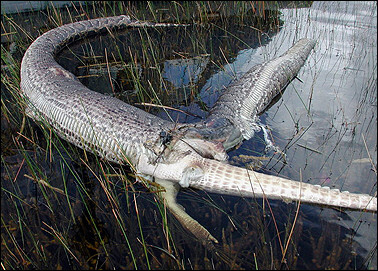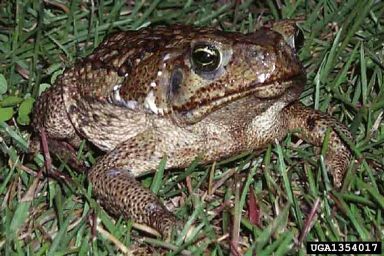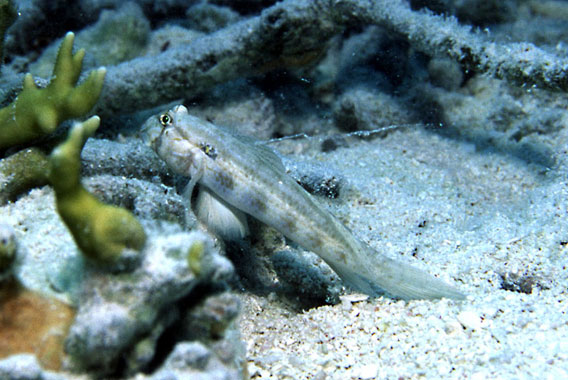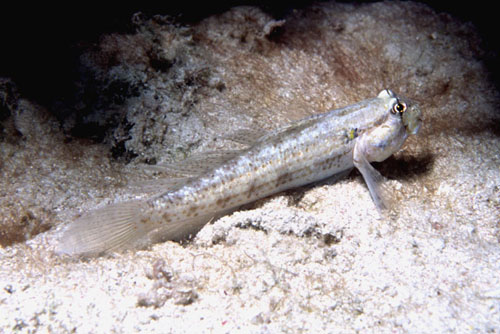Invasive species may increase with global warming
mongabay.com
October 13, 2005
 Michael Barron of the National Park Service took this picture of a carcass of an alligator as it protudes out from the body of a dead Burmese python in Everglades National Park, Florida. The Burmese python is an invasive species — 144,000 have been imported to the U.S. in the past five years for the pet trade. |
New research published in Molecular Ecology suggests that climate change could trigger the expansion of invasive species into wider ranges. The study looked at the genetic history of a goby species in the Eastern Atlantic which appears to have expanded its range dramatically when the world warmed about 150,000 years ago.
The finding has broader implications beyond aquatic reef fish. Invasive species cause billions of dollars in damage per year. In the United States alone, the economic cost of invasive species — in terms of the damage they do and the expense of controlling them — is estimated at $137 billion a year, according to a study by Cornell University in 1999. Should global warming fuel the arrival of more non-native species, the cost — both economic and ecological — will likely rise as well.
Why are invasive species so destructive?
While ninety percent of immigrant species do no obvious harm to their new home environment, a small number do disproportionate damage. By definition, “invasive species” are “an alien species whose introduction does or is likely to cause economic or environmental harm or harm to human health” (U.S. Executive Order 13112). Invasive species disrupt ecosystems primarily by preying on local species and competing with native species over limited resources. The effect on native biodiversity can be severe — the Cornell study says that 42% of the species on the Threatened or Endangered species lists are at risk primarily because of non-indigenous species. Introduced tilapia and Nile Perch have devastated endemic fish populations throughout Africa, while the snakehead, a carnivorous fish capable of walking across land, has raised fears every time it appears in a pond in the Eastern United States. Further, there can be significant economic costs to the damage caused by such aliens. For example, removing the zebra mussel from the Great Lakes alone will cost $5 billion.
 Cane Toads in Australia – Wreaking Havoc Down Under Everyone in Australia is in agreement that the cane toads have got to go. The problem is getting rid of them. Cane toads, properly known as bufo marinus, are the most notorious of what are called invasive species in Australia and beyond. But unlike other species of the same classification, cane toads were intentionally introduced into Australia. The country simply got much more and much worse than it bargained for. |
The mollusk is a problem because it clogs water intakes for factories, interferes with navigation, accelerates, decreases fuel efficiency, damages engines, reduces the amount of food available for other filter-feeding organisms and fish, and competes with native mussels.
A warmer climate could mean more foreign tropical species could find their way to, and thrive in, the United States. Florida and Hawaii, the country’s two most tropical states, have arguably suffered the most from invasive species. The python, a species of snake that has invaded the Everglades after pet owners have released it into the wild, has recently made headlines as it battles native alligators at the top of the food chain.
Dramatic battles aside, the ecological and economic threat from invasive species is real and should serve as a reminder to what’s in store for a warmer world.
 Gnatholepis goby. Courtesy of STRI. |
Ocean invaders in deep time
Smithsonian Tropical Research Institute
October 13, 2005
Much has been made of the economic impacts of recent biological invasions,
but what are the implications of invasions in deep time? Luiz Rocha leads
geneticists who time travel through ocean environments. The results of
their travels, published online in Molecular Ecology, tell us that during
warm, interglacial periods, reef-associated fish (goby genus Gnatholepis),
leapt around the horn of Africa into the Atlantic, where their range
expanded as the world warmed.
“We found that global warming events correspond clearly with major range
expansions of gobies from the Indian Ocean into the Atlantic Ocean and
subsequently into the Eastern Atlantic,” summarizes Rocha. A chilly
Antarctic current–the Benguela upwelling system– surges up along the
western coast of Africa acting as a natural barrier, and has prevented most
warm water organisms from the Indian Ocean from making it in to the Atlantic
for the last 2 million years. But when the world warmed about 150,000 years
ago, gobies slipped around the corner of the continent.
Researchers at the Smithsonian Tropical Research Institute, Scripps
Institution of Oceanography, Hofstra University and the University of
Hawaii, sequenced goby DNA (774 pb of the mtDNA of cytochrome b, to be
exact) from the western, central and eastern Atlantic Ocean. They also
sequenced DNA from gobies in the same genus from South Africa, from the
Cocos Keeling Islands in the eastern Indian Ocean, and from the Cook Islands
in the South Pacific. They calculate the approximate amount of time that
isolated groups of fish have been separate based on the differences in the
DNA between groups.
 Gnatholepis goby. Courtesy of STRI. |
What evidence do they have that makes them think that Atlantic gobies are
invaders? “The Atlantic goldspot goby certainly is a prime
candidate-it’s the only species of the genus in the Atlantic and there
are eight species and subspecies in the Indo-Pacific. It’s really similar
to a sister taxon in the Indian Ocean,” Rocha continues. “We nailed
down the timeline of the invasion by sequencing–the last time there was
tropical ocean connecting these two areas was 2 million years ago. We
calculate that these fish invaded the Atlantic Ocean during a warm period
about 150,000 years ago and arrived in the eastern Atlantic only 30,000
years ago.”
What future effects of climate change might we expect in the marine realm?
“Genetic analysis told us that fish from the Indian Ocean breached the
Benguela barrier in the past, and this barrier seems to open intermittently.
It would be reasonable to expect that other organisms limited by cold water
barriers will continue to expand their ranges during warm periods.”
Ref. Rocha, L.A., Robertson, D.R., Rocha, C., Van Tassell, J.L., Craig,
M.T., Bowen, B.W. 2005. Recent invasion of the tropical Atlantic by an
Indo-Pacific coral reef fish. Molecular Ecology online.
Smithsonian Tropical Research Institute
-
The Smithsonian Tropical Research Institute (STRI), a unit of the
Smithsonian Institution, with headquarters in Panama City, Panama, was
established to further our understanding of tropical nature and its
importance to human welfare, to train students to conduct research in the
tropics and to promote conservation by increasing public awareness of the
beauty and importance of tropical ecosystems.
Contact
-
Elisabeth King
Science Interpreter
Smithsonian Tropical Research Institute
Panama City, Panama
tel +507 212-8216
kingb (at) tivoli.si.edu
US (202) 786-2094 ext. 8216
fax +507 212-8148
US (202) 786-2094 ext. 8148
This is a modified news release from the Smithsonian Tropical Research Institute.